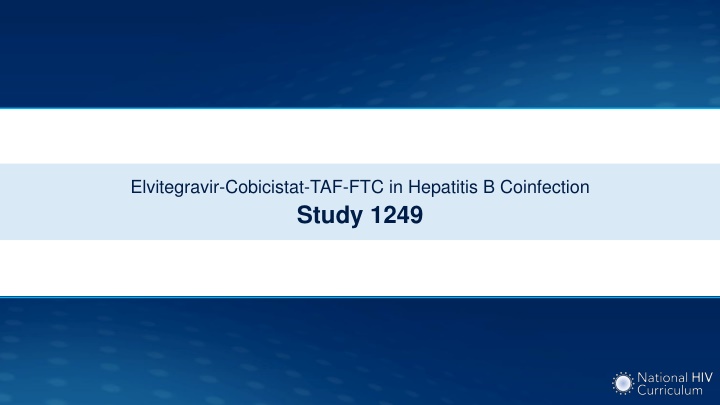
Elvitegravir Cobicistat TAF FTC Study Results in HIV/HBV Coinfection
Explore the study results of Elvitegravir-Cobicistat-TAF-FTC in HIV/HBV coinfection, including HIV and HBV efficacy at weeks 24 and 48, ALT measurements, changes in proteinuria, and more. Gain insights into the efficacy and safety profiles of this treatment regimen for individuals with dual HIV/HBV infection.
Download Presentation

Please find below an Image/Link to download the presentation.
The content on the website is provided AS IS for your information and personal use only. It may not be sold, licensed, or shared on other websites without obtaining consent from the author. If you encounter any issues during the download, it is possible that the publisher has removed the file from their server.
You are allowed to download the files provided on this website for personal or commercial use, subject to the condition that they are used lawfully. All files are the property of their respective owners.
The content on the website is provided AS IS for your information and personal use only. It may not be sold, licensed, or shared on other websites without obtaining consent from the author.
E N D
Presentation Transcript
Elvitegravir-Cobicistat-TAF-FTC in Hepatitis B Coinfection Study 1249
Elvitegravir-Cobicistat-TAF-FTC in HIV/HBV Coinfection Study 1249: Design Background: Open-label, single-arm, phase 3b trial evaluating switching to once-daily elvitegravir-cobicistat-tenofovir alafenamide- emtricitabine in adults with HIV and HBV 0 Study Week: 48 24 Inclusion Criteria (n = 72) - Adults with HIV and chronic HBV - HIV RNA <50 copies/mL for 6 months - Stable ART regimen for 4 months - CD4 200 cells/mm3 - CrCl 50 mL/min, ALT 10x ULN - No cirrhosis, HCC, HCV, hepatitis D Baseline ART (n = 72) EVG-COBI-TAF-FTC (n = 72) Treatment Arms - Switch to EVG-COBI-TAF-FTC Source: Gallant J, et al. J Acquir Immune Defic Syndr. 2016;73:294-8.
Elvitegravir-Cobicistat-TAF-FTC in HIV/HBV Coinfection Study 1249: Result HIV Efficacy at Weeks 24 and 48 Week 24 Week 48 100 94 92 80 HIV Efficacy (%) 60 40 20 6 4 3 1 0 HIV <50 copies/mL Virologic Failure No Virologic Data Source: Gallant J, et al. J Acquir Immune Defic Syndr. 2016;73:294-8.
Elvitegravir-Cobicistat-TAF-FTC in HIV/HBV Coinfection Study 1249: Result HBV Efficacy at Weeks 24 and 48, Missing = Failure Week 24 Week 48 100 92 86 80 HIV Efficacy (%) 60 40 20 10 6 4 3 0 HBV DNA <29 IU/mL Data Missing HBV DNA 29 IU/mL Source: Gallant J, et al. J Acquir Immune Defic Syndr. 2016;73:294-8.
Elvitegravir-Cobicistat-TAF-FTC in HIV/HBV Coinfection Study 1249: Subgroup Analysis Result ALT Measurement at Weeks 24 and 48 Week 24 Week 48 100 Participants with normal ALT (%) 92 87 80 60 50 40 40 20 4/10 54/62 5/10 57/62 0 Baseline ALT >ULN Baseline ALT normal Source: Gallant J, et al. J Acquir Immune Defic Syndr. 2016;73:294-8.
Elvitegravir-Cobicistat-TAF-FTC in HIV/HBV Coinfection Study 1249: Result Changes in General Proteinuria at Weeks 24 and 48 from Baseline Week 24 Week 48 0 Median Change in Proteinuria (%) -5 -4 -10 -10 -13 -15 -15 -20 Proteinuria (UPCR) Albuminuria (UACR) Source: Gallant J, et al. J Acquir Immune Defic Syndr. 2016;73:294-8.
Elvitegravir-Cobicistat-TAF-FTC in HIV/HBV Coinfection Study 1249: Result Changes in Tubular Proteinuria at Weeks 24 and 48 from Baseline Week 24 Week 48 0 Median Change in Tubular -6 -10 Proteinuria (%) -20 -22 -22 -30 -36 -40 -50 RBP:Cr 2M:Cr RBP:Cr = retinol binding protein:creatinine ratio; 2M:Cr = beta-2 microalbumin:creatinine ratio Source: Gallant J, et al. J Acquir Immune Defic Syndr. 2016;73:294-8.
Elvitegravir-Cobicistat-TAF-FTC in HIV/HBV Coinfection Study 1249: Conclusions Interpretation: In this first study in HIV/HBV-coinfected participants with suppressed HIV infection, E/C/F/TAF was effective against HIV and HBV, well tolerated, and demonstrated improvements in renal and bone safety consistent with the clinical profile of TAF. These data support the use of E/C/F/TAF in treating HIV/HBV coinfections. Source: Gallant J, et al. J Acquir Immune Defic Syndr. 2016;73:294-8.
Acknowledgments The National HIV Curriculum is supported by the Health Resources and Services Administration (HRSA) of the U.S. Department of Health and Human Services (HHS) as part of a financial assistance award totaling $1,021,448 with 0% financed with non-governmental sources. The contents are those of the author(s) and do not necessarily represent the official views of, nor an endorsement, by HRSA, HHS, or the U.S. Government. For more information, please visit HRSA.gov. This project is led by the University of Washington s Infectious Diseases Education and Assessment (IDEA) Program.
